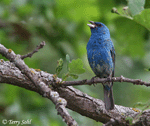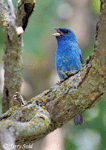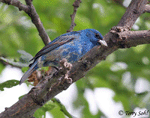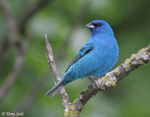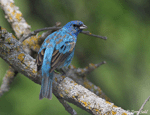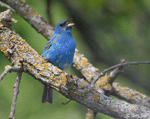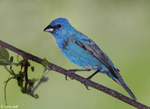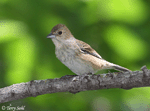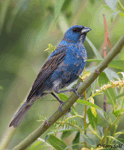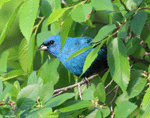| Length: 5.5 inches | Wingspan: 8 to 9 inches | Seasonality: Summer |
| ID Keys: Dark blue overall, darker blackish-blue wings and tail | ||
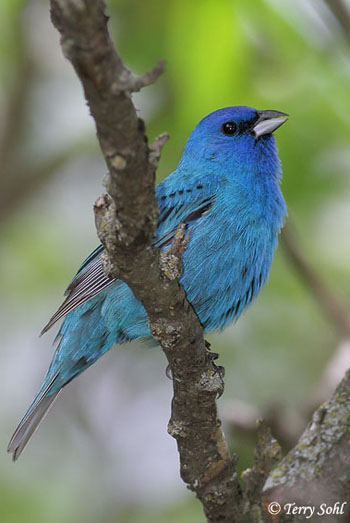 The Indigo Bunting is one
of the most abundant songbirds in parts of the eastern United States. They
avoid unbroken forest, strongly preferring forest edges and brushy
thickets. They are thus likely much more numerous today than in historical
times due to man's disturbance of the landscape. The brilliantly colored
male (pictured to the right) is an unmistakable sight, while the female (last
photo below) is a much more subtly plumaged bird.
The Indigo Bunting is one
of the most abundant songbirds in parts of the eastern United States. They
avoid unbroken forest, strongly preferring forest edges and brushy
thickets. They are thus likely much more numerous today than in historical
times due to man's disturbance of the landscape. The brilliantly colored
male (pictured to the right) is an unmistakable sight, while the female (last
photo below) is a much more subtly plumaged bird.
Habitat: Prefers brushy areas for breeding, such as woodland edges, shelterbelts, brushy fields, and 2nd-growth forest.
Diet: Primarily feeds on insects and spiders during summer breeding months. Will also feed on seeds and berries, especially in the winter.
Behavior: Often forages by moving through the foliage, gleaning insects from leaves and branches, and occasionally flying out to capture an insect in mid-air. They will also forage along the ground, especially in winter as the diet begins to include more seeds and berries. They can be found foraging at all levels of vegetation, from the ground to the tree tops.
Nesting: June and July
Song: Indigo Bunting song
Migration: Summers through the entire eastern United States and portions of the Southwest. Winters in southern Florida, extreme southern Texas, Mexico, and southward.
Interactive eBird map: Click here to access an interactive eBird map of Indigo Bunting sightings
Similar Species: Blue Grosbeak, Lazuli Bunting. See the Identification Tips page for differentiating between these species.
Conservation Status: Has extended range into much of the southwestern United States, but at the same time, has decreased in numbers in areas of intense agriculture and urban development.
Bird Feeders: Will come to feeders for small seeds and grains.
South Dakota "Hotspot": Although not difficult to find in suitable habitat in South Dakota, I've found them easiest to find and photograph at Newton Hills State Park, in Lincoln County.
Further Information: 1) USGS Patuxent Bird Identification InfoCenter, Indigo Bunting
3) Audubon Guide - Indigo Bunting
Photo Information: June 2007 - Newton Hills State Park - Terry Sohl
Additional Photos: Click on the image chips or text links below for additional, higher-resolution Indigo Bunting photos.
| Click on the map below for a higher-resolution view |
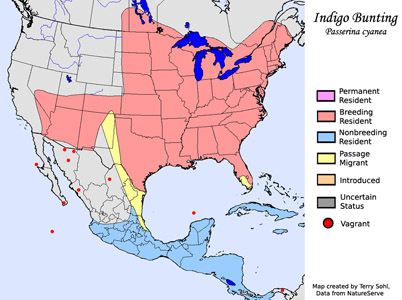 |
| South Dakota Status: Common summer resident in the southeast and northeast corners of the state. Uncommon elsewhere in suitable habitat. |
Additional Indigo Bunting Photos
Click for a higher-resolution version of these photos
